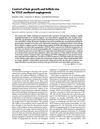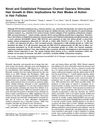Minoxidil-Induced Hair Growth Is Mediated by Adenosine in Cultured Dermal Papilla Cells: Possible Involvement of Sulfonylurea Receptor 2B as a Target of Minoxidil
December 2001
in “
Journal of Investigative Dermatology
”

TLDR Minoxidil boosts hair growth by targeting adenosine and possibly sulfonylurea receptor 2B.
This study from 21 years ago aimed to understand the mechanism by which minoxidil induces hair growth. The researchers found that adenosine, a signaling molecule, plays a role in the process and that the sulfonylurea receptor 2B (SUR2B) may be a target of minoxidil. The study also showed that DPCs have multiple adenosine-dependent signaling pathways and that SUR2B is present in DPCs, providing a possible binding site for minoxidil and a mediator for adenosine production. The researchers proposed a signaling pathway linking minoxidil-induced VEGF upregulation to adenosine, and adenosine receptors mediate the increase in [Ca²+]i levels and VEGF production in cultured DPC. The study suggests that the adenosine/VEGF pathway in cultured DPC might play an important role in hair growth.








